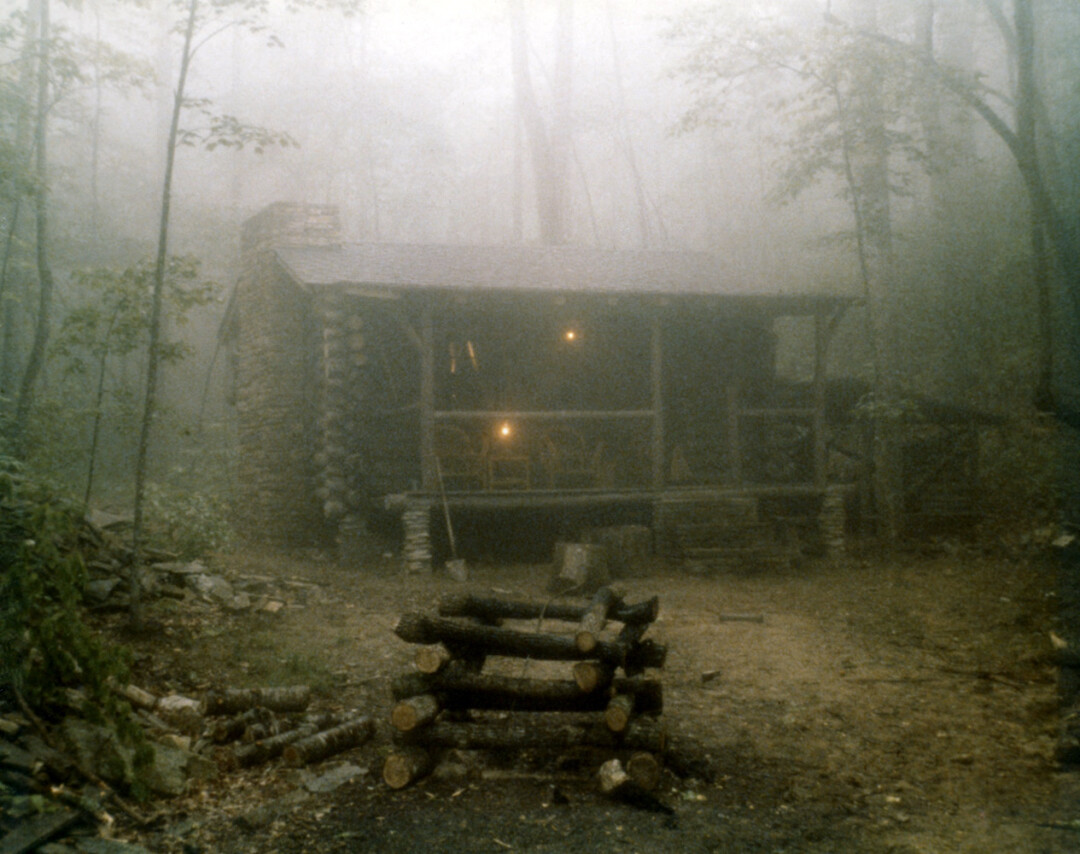Little Frights in the Big Woods
bizarre tales of spirits tossing axes in the 1870s

It was a little house in the Big Woods – a two-story log cabin occupied by a growing family amid the towering elms, sugar maples, and red oaks of western Wisconsin. The house sat in a clearing in a frontier area of the still-young state, and while a lumber boom was soon to build not far away in the vast stands of white pines, at the Lynch homestead near Hatchville life revolved around farming. Richard Lynch, his wife, Elizabeth, and five children – ranging in age from 20 to 2 – had moved to this corner of St. Croix County in 1871 from Indiana in search of improved circumstances.
It wasn’t long, however, before circumstances became strange – even terrifying. What menaced the Lynch family wasn’t some force of nature nor the untamed wildlife that roamed the Big Woods. It wasn’t the Native Americans who so recently had been pushed from these lands. It was something, perhaps, beyond human comprehension.
What troubled the Lynches for several years in the 1870s attracted attention to the family and visits from journalists, spiritualists, and curiosity seekers of all kinds, drawing a spotlight to the humble family that remains, though dimmed a bit by time, nearly a century and a half later. In the flowery prose of the Dunn County News of Sept. 13, 1873, “The occurrences possess all the romantic interest which first attended the physical manifestations of modern spiritualism – Chairs jumping to the ceiling and then falling to the floor with terrible force; crockery and tinware going across the room like lightning, propelled by some invisible agency. Billets of wood, pieces of board, axes, handspikes, etc., etc., hurled through the air by unseen hands. Incidents are related, which, if true, lay everything completely in the shade, we ever heard, or read, concerning spiritualism, witchcraft, or the thousand-and-one things that have mysteriously happened, and for which superstitious people hold ‘Auld Clootie’ directly responsible.”
For those unfamiliar with Scottish folklore, “Auld Clootie” is a nickname for the Devil himself. Was Satan or one of his demons raising hell at the Lynch home? Or was the explanation much more earthly?
"THE GREAT MYSTERY!!"
The Lynches lived in the Town of Cady in the extreme southeast corner of St. Croix County, just across the county line from Dunn County to the east and Pierce County to the south. About 13 miles to the east lay the city of Menomonie, home to the Dunn County News, whose coverage of the Lynch case helped bring it national – and even international – attention.
By sheer coincidence, the Lynches lived in a time and place well-remembered in children’s literature. The Lynch homestead was just 30 miles north (as the crow flies) from the home of the Charles Ingalls family near Pepin, the birthplace of Laura Ingalls Wilder. The latter home is the settling of Ingalls’ first book, Little House in the Big Woods. In fact, the Ingalls family was living in near Pepin at the time of the events at the Lynch home, they were to move to Walnut Grove, Minnesota, a few months later, in February 1874.
While Little House in the Big Woods is a comforting tale full of the small, homey details of frontier life, it lacks the excitement of what was occurring a few miles away at the Lynch home. As the Dunn County News reported in September 1873 (under the headline “THE GREAT MYSTERY!!”), strange incidents began occurring in the Lynch household in late 1871. Items of Mrs. Lynch’s clothing began to disappear, only to be found rolled up and tucked into nooks and crannies, shredded beyond repair. When backs were turned, household objects – teacups, plates, dishes – would be smashed to the floor.
At first, the Lynches suspected that their 7-year-old son, Georgie, was behind the mischief, and his mother would bind him to a chair as punishment. Yet objects continued to fly about. “There mother,” Georgie would pipe up, “you see I didn’t do that.”
The incidents escalated. When Mrs. Lynch wasn’t looking, 2-year-old Rena’s head full of ringlets was shorn almost to the scalp, “but not a single vestige of the severed hair was ever seen afterward.” A pot of squirrel stew vanished from the stove, only to be found – still bubbling – atop a bed, hidden under a blanket.
In August 1873, a neighbor, Frank Duffie, was helping Mr. Lynch make hay when they were called into the house for dinner. “On their arrival they found things decidedly lively,” the News reported a few weeks later. “Chairs jumped to the ceiling and fell to the floor; tinware and cooking utensils flew across the room at lightning speed; crockery, spoons, etc., would leave their accustomed places upon the dresser, and assemble in one particular corner of the room. Outside the house pieces of board, scraps of iron and other movable things about in the same mysterious manner.”
Determined to catch the culprit, the two men stationed themselves at opposite corners of the house. They saw no one, but more objects – a large pine box, a horseshoe – continued to become airborne. The rest of the family was called out of the house and stood together in the corner of the yard. “Immediately there commenced a terrible din and racket in the house, lasting for several minutes,” the News reported. “Returning, they found about everything moveable there was in the house piled up in one corner.” Whoever – or whatever – was at work apparently enjoyed chaos.
That same day – though the order of events is unclear – a broad ax which was sticking in a log a dozen feet from the home leapt up, struck the doorway, and bounced inside. Mrs. Lynch grabbed the ax and marched to the milkhouse, where she stuck it inside a box weighted down with a bag of salt. Minutes later, however, it clattered back onto the porch.

MOTIVATED MISCHIEF?
In his 2011 book Haunted Wisconsin, which chronicles eerie Badger State happenings across the centuries, author Michael Norman calls the Lynch affair “one of the most sensational ‘hauntings’ ever reported in Wisconsin.” While contemporary accounts of the Lynch phenomenon used words such as “spirit” and “ghost,” Norman and other recent writers use a term that probably wasn’t in circulation in Wisconsin in the 19th century: poltergeist.
Literally translated from German, the word “poltergeist” means “noisy ghost.” Such troublesome spirits have popped up in folklore around the world for centuries. To true believers, poltergeist activity is the world of evil (or at least mischievous) spirits, while others believe they are manifestations of psychokinesis: the ability of some particularly gifted human beings to move objects without touching them. To skeptics, however, poltergeists are merely hoaxes, often the work of troublesome children who manage to mystify gullible adults. As skeptic and author Joe Nickell has written, there you find a poltergeist you typically also find “an individual .... who is motivated to cause the mischief.”
“In the typical poltergeist outbreak,” he wrote in his 2012 book, The Science of Ghosts, “small objects are hurled through the air by unseen forces, furniture is overturned, or other disturbances occur – usually just what could be accomplished by a juvenile trickster determined to plague credulous adults.”
The spiritualist movement was near its height in the United States in the 1870s, and seances and other methods of reaching out to the spirit world were not unusual. As such, the Lynch farm attracted its share of spiritualists, clairvoyants, and mediums. According to the Dunn County News, a clairvoyant from Pierce County said he sensed seven spirits – including that of Mr. Lynch’s late first wife – and said they were raising a fuss to “awaken their minds and the minds of the community to the truths of spiritualism.” Another medium, this one from River Falls, advised the family hold a seance, though this proved unproductive (other than the table moving around).
A news of the bizarre activities at the Lynches spread, curious visitors began flocking to the farmhouse. Author Norman notes that the publicity attracted pilgrims from as far as Norway, Sweden, Germany, France, and England, all of them “attracted by the prospect of seeing ‘spirits’ at work.” Upstanding individuals – from newspaper editors to preachers to school superintendents – witnessed oddities such as teacups tossing themselves to the floor and spontaneously spinning to eggs and potato mashers flying about.
“Perhaps we were fooled by some trick of legerdemain,” the Dunn County News reporter pondered. “If so, who did it? The boy seven years old who sat at the table quietly eating his breakfast? The girl, ten years old, who stood by, wiping a dish? Mrs. Lynch, who was busy at work? Or Mr. Lynch, who was not at the house? It seems to us improbable, if not impossible. What, then, caused these movements? That is a conundrum we cannot answer. It may be a spirit, animal magnetism, odylic force, witchcraft or the devil for aught we know.”
The News reporter seemed truly baffled and was convinced that the Lynches were not perpetrating a fraud. Other observers weren’t so certain. Consider an unnamed corresponded from the St. Paul Dispatch, whose investigation was reprinted in the Dunn County News in November 1873. “The house is a dismal waste of dilapidated household goods,” recorded the correspondent, who encountered no fewer than four other visitors when he arrived at the Lynch farm. The St. Paul writer relayed several bizarre tales, most notably that of the Rev. John Barker, “a devout Christian and an intelligent gentleman,” who brought a Bible and prayer book to the Lynch home, wrapped them in a handkerchief, and put them on the stairs. The books vanished when he was momentarily distracted, and the reverend later recovered his Bible from atop a bed – all of its pages ripped out. As he stood in astonishment, “a broad ax came whirling into the door, and struck at his feet.”
THE CURIOUS FACT
Despite such stories, the St. Paul writer dismissed any supernatural cause for the Lynch mystery. He noted that an estimated 300 people had visited the farm over the course of six weeks, many of them offering to pay for their accommodations – payments the Lynches gladly accepted. In not so many words, he implies that the Lynches were running a bed-and-breakfast with a side of otherworldly entertainment.
He also pointed out the “curious fact … that no one sees any article voluntarily start.” In his opinion, swift-moving human hands – not supernatural forces – were at work.
“In the Envoy’s mind,” the reporter wrote, referring to himself in the third person, “it is perfectly clear that the family is responsible for all these mysterious developments.” He goes on to speculate that some members of the family were playing tricks on a gullible Mr. Lynch and his equally credulous visitors. His theory: “Mrs. Lynch becoming lonely in her dreary backwoods home, is said to be very anxious for her husband to see his farm and go East. … She has at last become desperate, and in conjunction with her twelve year old daughter (who by the way is a strange and precocious child), has not only succeeded in partly duping her superstitious husband, but has blinded very many other good people.”
A clue that the St. Paul Dispatch writer’s skepticism may have been warranted can be found in one of the Dunn County News’ final articles on the Lynch affair: On Oct. 25, 1873, the News reported that a frustrated Mr. Lynch had sent 10-year-old Mary and 7-year-old Georgie to stay with a neighbor. “Since their departure … not the slightest disturbance has occurred, and not a single movement has been detected since their absence.”
Case closed? Perhaps. The Lynch family eventually moved away from the region, author Norman writes, and their homestead is long gone, replaced by a country road and farmers’ fields. Their supernatural story, however, has had a long afterlife. Among the national periodicals that reported on the Lynch mystery was the Religio-Philosophical Journal of Chicago, at the time a major spiritualist publication. In the early 20th century, Charles Hoy Fort – the granddaddy of paranormal research – cited this journal’s coverage of the Lynch case in his book about unexplained phenomena, Wild Talents, which was published in 1932 and remains in print.
In fact, it’s probably because of Fort’s influence – his surname inspired the term “Fortean,” which is used to describe supernatural or anomalous phenomena – that anyone today remembers the Lynch case. A 1965 article in Practical English magazine, which drew details from Fort’s book, attracted the attention of the Menomonie Chamber of Commerce – apparently, nearly a century later, the Lynch case had been forgotten in western Wisconsin. Subsequently, the Lynches and the spirt (or spirits) that troubled them have been recounted numerous articles and books, and a few years ago even were part of the entertainment during a “Ghosts of Dunn County” event at the Rassbach Heritage Museum in Menomonie.
The Lynches may be long gone, but the spirits they stirred up still live on.

